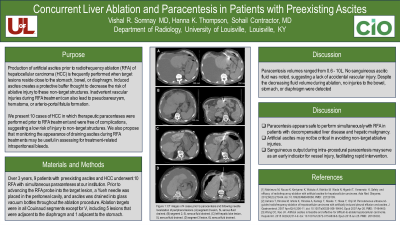Ablative Therapy
(27) Concurrent Liver Ablation and Paracentesis in Patients with Preexisting Ascites
Saturday, September 23, 2023
6:00 PM - 7:30 PM East Coast USA Time

Hanna Thompson, BS – Medical Student, University of Louisville; Sohail Contractor, MD – Chair of Radiology and Interventional Radiology Attending, Radiology, University of Louisville
Purpose: Production of artificial ascites prior to radiofrequency ablation (RFA) of hepatocellular carcinoma (HCC) is frequently performed when target lesions reside in close proximity to the stomach, bowel, or diaphragm. Induced ascites creates a protective buffer thought to decrease the risk of ablative injury to these non-target structures. Inadvertent vascular injuries during RFA treatment can also lead to pseudoaneurysm, hematoma, or arterio-portal fistula formation.
We present 10 cases of HCC in which therapeutic paracenteses were performed prior to RFA treatment and were free of complications, suggesting a low risk of injury to non-target structures. We also propose that monitoring the appearance of draining ascites during RFA treatments may be useful in assessing for treatment-related intraperitoneal bleeds.
Material and Methods: Over 3 years, 9 patients with preexisting ascites and HCC underwent 10 RFA with simultaneous paracenteses at our institution. Prior to advancing the RFA probe into the target lesion, a Yueh needle was placed in the peritoneal cavity, and ascites was drained into glass vacuum bottles throughout the ablation procedure. Ablation targets were in all Couinaud segments except for V, including 5 lesions that were adjacent to the diaphragm and 1 adjacent to the stomach.
Results: Paracentesis volumes ranged from 0.6 - 10L. No sanguineous ascitic fluid was noted, suggesting a lack of accidental vascular injury. Despite the decreasing fluid volume during ablation, no injuries to the bowel, stomach, or diaphragm were detected.
Conclusions: Paracentesis appears safe to perform simultaneously with RFA in patients with decompensated liver disease and hepatic malignancy. Artificial ascites may not be critical in avoiding non-target ablative injuries. Sanguineous output during intra-procedural paracentesis may serve as an early indicator for vessel injury, facilitating rapid intervention.
We present 10 cases of HCC in which therapeutic paracenteses were performed prior to RFA treatment and were free of complications, suggesting a low risk of injury to non-target structures. We also propose that monitoring the appearance of draining ascites during RFA treatments may be useful in assessing for treatment-related intraperitoneal bleeds.
Material and Methods: Over 3 years, 9 patients with preexisting ascites and HCC underwent 10 RFA with simultaneous paracenteses at our institution. Prior to advancing the RFA probe into the target lesion, a Yueh needle was placed in the peritoneal cavity, and ascites was drained into glass vacuum bottles throughout the ablation procedure. Ablation targets were in all Couinaud segments except for V, including 5 lesions that were adjacent to the diaphragm and 1 adjacent to the stomach.
Results: Paracentesis volumes ranged from 0.6 - 10L. No sanguineous ascitic fluid was noted, suggesting a lack of accidental vascular injury. Despite the decreasing fluid volume during ablation, no injuries to the bowel, stomach, or diaphragm were detected.
Conclusions: Paracentesis appears safe to perform simultaneously with RFA in patients with decompensated liver disease and hepatic malignancy. Artificial ascites may not be critical in avoiding non-target ablative injuries. Sanguineous output during intra-procedural paracentesis may serve as an early indicator for vessel injury, facilitating rapid intervention.
